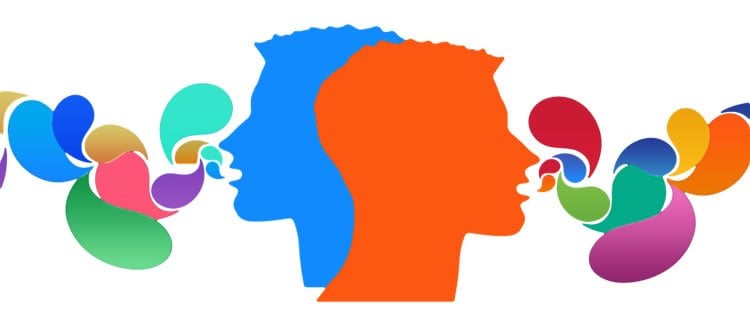Summary: A new study looks at how our brains synchronize when we converse with other people. Researchers found the rhythms of brainwaves adjust in both the speaker and listener according to the physical properties of sounds expressed when talking.
Source: FECYT.
The rhythms of brainwaves between two people taking part in a conversation begin to match each other. This is the conclusion of a study published in Scientific Reports, led by the Basque research centre BCBL. According to scientists, this interbrain synchrony may be a key factor in understanding language and interpersonal communication.
Until now, most traditional research had suggested the hypothesis that the brain “synchronises” according to what is heard, and correspondingly adjusts its rhythms to auditory stimuli.
Now, the experts from the Donostia-based research centre have gone a step further and simultaneously analysed the complex neuronal activity of two strangers while holding a dialogue for the first time.
The team, led by Alejandro Pérez, Manuel Carreiras and Jon Andoni Duñabeitia, has confirmed by recording cerebral electrical activity- that the neuronal activity of two people involved in an act of communication “synchronise” in order to allow for a “connection” between both subjects.
“It involves interbrain communion that goes beyond language itself and may constitute a key factor in interpersonal relations and the understanding of language,” Jon Andoni Duñabeitia explains to SINC.
Thus, the rhythms of the brainwaves corresponding to the speaker and the listener adjust according to the physical properties of the sound of the verbal messages expressed in a conversation. This creates a connection between the two brains, which begin to work together towards a common goal: communication.
“The brains of the two people are brought together thanks to language, and communication creates links between people that go far beyond what we can perceive from the outside,” added the researcher from the Basque research centre. “We can find out if two people are having a conversation solely by analysing their brain waves.”
What is neural synchrony?
For the purposes of the study, the BCBL researchers used 15 dyads of people of the same sex, complete strangers to each other, separated by a folding screen. This ensured that the connection generated was truly thanks to the communication established.
Following a script, the dyads held a general conversation and took turns playing the roles of speaker and listener.
Through electroencephalography (EEG) – a non-invasive procedure that analyses electrical activity in the brain – the scientists measured the movement of their brainwaves simultaneously and confirmed that their oscillations took place at the same time.
“To be able to know if two people are talking between themselves, and even what they are talking about, based solely on their brain activity is something truly marvellous. Now we can explore new applications, which are highly useful in special communicative contexts, such as the case of people who have difficulties with communication,” Duñabeitia pointed out.

In the future, the understanding of this interaction between two brains would allow for the comprehension and analysis of very complex aspects of the fields of psychology, sociology, psychiatry, or education, using the neural images within an ecological or real-world context.
“Demonstrating the existence of neural synchrony between two people involved in a conversation has only been the first step,” confirmed Alejandro Pérez. “There are many unanswered questions and challenges left to resolve.”
Pérez further maintains that the practical potential of the study is enormous. “Problems with communication occur every day. We are planning to get the most out of this discovery of interbrain synchronisation with the goal of improving communication,” he concluded.
The next step for the researchers will be to learn, by applying the same technique and pair dynamic, if the brains of two people “synchronise” in the same way when the conversation takes place in their non-native language.
Source: FECYT
Image Source: NeuroscienceNews.com image is in the public domain.
Original Research: Full open access research for “Brain-to-brain entrainment: EEG interbrain synchronization while speaking and listening” by Alejandro Pérez, Manuel Carreiras & Jon Andoni Duñabeitia in Scientific Reports. Published online June 23 2017 doi:10.1038/s41598-017-04464-4
[cbtabs][cbtab title=”MLA”]FECYT “Our Brains Synchronize During Conversation.” NeuroscienceNews. NeuroscienceNews, 20 July 2017.
<https://neurosciencenews.com/conversation-brain-synchronization-7135/>.[/cbtab][cbtab title=”APA”]FECYT (2017, July 20). Our Brains Synchronize During Conversation. NeuroscienceNew. Retrieved July 20, 2017 from https://neurosciencenews.com/conversation-brain-synchronization-7135/[/cbtab][cbtab title=”Chicago”]FECYT “Our Brains Synchronize During Conversation.” https://neurosciencenews.com/conversation-brain-synchronization-7135/ (accessed July 20, 2017).[/cbtab][/cbtabs]
Abstract
Brain-to-brain entrainment: EEG interbrain synchronization while speaking and listening
Electroencephalographic hyperscanning was used to investigate interbrain synchronization patterns in dyads of participants interacting through speech. Results show that brain oscillations are synchronized between listener and speaker during oral narratives. This interpersonal synchronization is mediated in part by a lower-level sensory mechanism of speech-to-brain synchronization, but also by the interactive process that takes place in the situation per se. These results demonstrate the existence of brain-to-brain entrainment which is not merely an epiphenomenon of auditory processing, during listening to one speaker. The study highlights the validity of the two-person neuroscience framework for understanding induced brain activity, and suggests that verbal information exchange cannot be fully understood by examining the listener’s or speaker’s brain activity in isolation.
“Brain-to-brain entrainment: EEG interbrain synchronization while speaking and listening” by Alejandro Pérez, Manuel Carreiras & Jon Andoni Duñabeitia in Scientific Reports. Published online June 23 2017 doi:10.1038/s41598-017-04464-4






